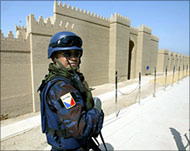US graffiti on ancient Babylon’s walls
Hammurabi the law-giver was here. So were Nebuchadnezzar, Alexander the Great, Saddam Hussein and now, apparently, Sergeant Woods.

US soldiers are the latest in a long line of powerful forces visited on ancient Babylon and they have left their mark, in graffiti scratched into walls Saddam added in the hope of joining his predecessors’ pantheon.
“Folks come through here and are like, ‘Kilroy was here’,” says Major David Gilleran, an army chaplain guiding 16 US reservists among the mud-brick walls and shards of cuneiform-inscribed tablets.
Carrying automatic weapons, US soldiers and their foreign allies walk through the world-famous cradle of civilisation, now within the walls of a military base run by Polish soldiers 80km south of Baghdad.
“You could almost say all roads lead to Babylon,” says Gilleran, 50, from Daphne, Alabama. “This is a focal point in history. Alexander the Great was fascinated with Babylon. Saddam, too.
“This place represents the greatness in human history. We’re just passing through.”
Welcome departure
Iraqi security forces are supposed to take over the base by the year’s end, and Iraqis say they cannot wait.
 |
|
Babylon dates back 4000 years |
“For me, Americans and Polish, out!” a man at the site said in English. “Babylon is 4000, 5000 years [old]. It’s for all civilisations, not Americans. They must go.” He asked not to be identified.
“The Americans are here. They’ve occupied the country and put Saddam away, and I think everyone appreciates that,” said Donny George, a Ministry of Culture official, who directed an archaeological dig at Babylon during Saddam’s time.
“But going back to these ancient cities, it does nothing for the image of the Americans,” George said.
Hammurabi’s code
The English-language graffiti is not widespread and does not appear to have caused extensive harm. Arabic script is also scrawled on the walls. US-led forces have spent tens of thousands of dollars repairing ruins and protecting them from looters, and are investigating whether US and Polish heavy machinery and rotor wash from helicopters are inflicting damage.
|
“Babylon surpasses in splendor any city in the known world” Greek historian Herodotus |
The city dates back some 4000 years. Hammurabi, credited as the first ruler to encode law, made it his capital. His code, written 1700 years before Christ, includes the timeworn maxim: “If a man put out the eye of another man, his eye shall be put out.”
Rebuilt by Nebuchadnezzar more than 1000 years later, the city boasted the Hanging Gardens of Babylon, one of the seven wonders of the ancient world.
Nebuchadnezzar sent his vast army from here to Jerusalem to put down an uprising and bring the Jews back as slaves. “Babylon surpasses in splendour any city in the known world,” wrote Herodotus, the Greek historian, in the 400s BCE.
Alexander the Great died suddenly in Babylon around 320 BCE, possibly poisoned. Saddam Hussein rebuilt atop Nebuchadnezzar’s original walls, to the chagrin of archaeologists.
Following orders
“There were direct orders from Saddam to put up the walls. As archaeologists, we didn’t like this, but we couldn’t say no at that time,” George, the ministry official, said.
 |
|
Saddam ordered walls to be put |
The site, which includes a 2600-year-old stone lion, its snout missing, drew few foreign tourists during Saddam’s government.
Now US-led forces photograph Saddam’s walls, studded with bricks recording his claims of glory.
“My kingdom will last forever,” Gilleran translates from the classical Arabic script, to chuckles from the American soldiers.
Gilleran offers words of caution, though: “America’s a young country. We have Jamestown, Williamsburg. This is another, 3000 years older. Americans need to stop and think a bit. We’re a great power, but we weren’t the first. We need to treat sites like this with reverence.”
Then, pointing up to a Saddam-era palace looming over the ruins, he lays out his own scenario for the future: “It’s possible to imagine a Marriott with a five-star restaurant. There could be a bed and breakfast up there.”